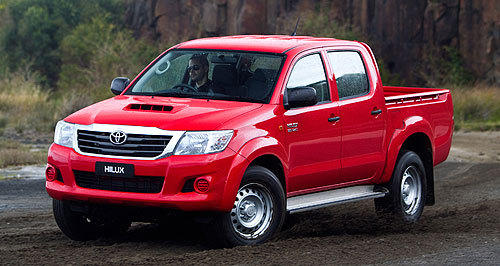Make / Model Search
News - General News - SafetyBHP Billiton changes the rulesSafety first: Mining company BHP Billiton found that add-on ‘safety’ accessories on utes such as the Toyota HiLux were not all they were cracked up to be. How the world’s biggest miner dug up new evidence on ute safety25 Sep 2012 By IAN PORTER THE world’s largest mining company, BHP Billiton, has prompted the world’s largest vehicle maker, Toyota, to elevate two of its key models – HiLux and LandCruiser – to five-star crash safety status as quickly as possible. BHP has decided to only purchase light vehicles – primarily one-tonne utilities and four-wheel-drive wagons – which have achieved the maximum five-star rating under the independent Australasian New Car Assessment Program (ANCAP) or overseas equivalent. After a thorough assessment of vehicle-related safety, the mining giant is also prohibiting the installation of certain aftermarket equipment and is urging car manufacturers to offer more factory-fit technology in light commercial vehicles, such as intelligent ignition keys and advanced in-vehicle monitoring systems (IVMS). The company’s new policy is likely to have an impact on all manufacturers of utilities and commercial 4WDs thanks to its buying power around the world, and the fact that the decision also applies to vehicles brought onto its mine sites by contractors. BHP itself owns or leases about 10,000 light vehicles at its 80-odd mine sites around the world, while its contractors operate a further 45,000 vehicles.  Left: BHP Billiton's David Jenkins. Left: BHP Billiton's David Jenkins.Toyota has already announced that it will produce an out-of-sequence refresh on the HiLux to lift it to a five-star crash rating from October 2013, while the LandCruiser 200 Series will be five-star-rated from the first quarter of 2013. The Japanese auto giant has also admitted there is no replacement for the rugged LandCruiser 70 Series, which due to the unavailability of electronic stability control (ESC) and side curtain airbags will never achieve a five-star rating and is expected to be discontinued within the next five years. This is despite the development of an all-new dual-cab model and the recent introduction of a safety upgrade which finally includes an anti-lock braking system (ABS). When BHP did a survey of its light vehicle fleet a few years ago, it found 90 per cent of the vehicles in use around the world were not fitted with ESC, few had curtain airbags and some did not have even dual front airbags. BHP Billiton safety and security vice-president David Jenkins said a significant number of the company’s vehicles had ABS. “In the past we had a high number of light-vehicle incidents and some vehicle rollover fatalities, although the last rollover fatality was some considerable time ago,” Mr Jenkins told a meeting of the Society of Automotive Engineers – Australasia in Melbourne. Mr Jenkins said that even when the same model ute was bought in different countries, it would have different safety specifications. The industry dealt with this by retrofitting equipment, in particular rollover protection systems (ROPS). But Mr Jenkins said “mission creep” meant operators added more and more equipment such as battery isolation switches, jump-start receptacles, bullbars, rollover protection bars, fire extinguishers and IVMS. “We kept putting more and more stuff on our vehicles but, actually, our vehicle safety record didn’t improve that much,” he said. Mr Jenkins said BHP’s records on significant incidents from recent years showed 19 rollovers, with most involving a partial rollover and only one involving a roll of more than 360 degrees. The company experienced far more accidents involving light vehicles being run over by 300-tonne ore movers in open-cut mine pits. So, BHP clamped down on pit licences to reduce the number of light vehicles in the mines. On one site, pit licences for light-vehicle drivers were cut by 75 per cent. “If you’re not there, you can’t get run over,” he said. Furthermore, the company encouraged drivers who used their utes only to commute to the mine site to switch to safer sedans. In the pits, where there was sufficient space, the company also segregated the traffic by giving the light vehicles their own road in parallel with the track used by ore trucks. BHP decided to test utes see if all the expensive aftermarket additions being tacked on to them improved safety. The company took four utes at the end of their leases to NSW’s road safety research unit, Crashlab, and had them put through some typical accident situations. All the utes had bullbars and three had rollover protection inside the cab. The 64km/h frontal offset crash showed that a ute fitted with a bullbar suffered deformation in the footwell area, with the accelerator and clutch pedals ending up crossed over. The standard vehicle had no deformation in the footwell when it was crash-tested in 2006. Mr Jenkins pointed out that the BHP vehicle fitted with ROPS and bullbar weighed 250kg more than the standard ute. The rear seatbelt foundation also failed – not seen in the standard vehicle test – resulting in a potentially fatal blow to the head for the rear-seat passenger. The 75km/h rollover test was more startling. The vehicle without ROPS was used first and turned through 90 degrees on to its side. The vehicle was still usable, so Crashlab ran the test again, only this time 35kg of weight was added in the upper cabin to represent the ROPS system. This time, the vehicle turned straight over on to its roof. He said this did not mean a ROPS would cause a ute to roll. But, if the vehicle was in an unstable condition, the added momentum of the ROPS might aggravate that instability. Mr Jenkins read the final report from Crashlab, which said: “The internal ROPS fitted to the vehicle demonstrated limited potential for additional protection for front-seat occupants in any of the tested crash configurations. “The ROPS did not eliminate roof crush over the front-seat occupants in the tested rollover crashes and offers no real reduction in any potential serious head and spinal injuries for these occupants in that type of crash.” Mr Jenkins pointed out that if you have a serious multi-roll accident, ROPS will make a difference. But he said BHP was not seeing that type of crash in its incident reports. He also stressed that the results achieved at Crashlab could not be used as a generic guide to all one-tonne utilities. In light of the crash results, BHP changed its light-vehicle policy on May 18, 2012. The whole fleet must be changed over by January 2016. From now on, all new BHP vehicles anywhere in the world must have a five-star NCAP rating. The new rules prohibit the installation of aftermarket equipment, except for minor exceptions such as where equipment is needed for visibility or communications. Apart from the safety benefits, the new rules will save the company and its contractors a lot of money and time. Mr Jenkins said it once cost between $25,000 and $30,000 to fit out vehicles with ROPS, bullbars and other aftermarket gear. And it took eight weeks. Now BHP’s light vehicles cost less than $15,000 to prepare for work in the pit, with reflective stripes, two-way radio and an appropriate tray. Mr Jenkins said the new policy fitted in with part of BHP’s charter, which is to keep things as simple as possible. He said the previous light-vehicle standard for BHP’s metallurgical coal division ran for 45 pages. The standard now covers half a page with only six bullet points. However, these new policies will not solve all the problems, he admitted. Mr Jenkins said he still had a wish list he would like to be able to implement. These included intelligent ignition keys so speeds could be limited in certain areas or acceleration curbed so the chances of getting into trouble are much less. “That would be perfect,” he said. “If I could just have an intelligent ignition key for the mine site and another for the open road – just swap them at the gate – I don’t have to worry about someone speeding on the site because I know they can’t.” Other features he would like to see include factory-fitted IVMS (in-vehicle monitoring systems) and fatigue detection systems, the latter only appearing in some sedans but not utilities at this stage. “We spend a fortune on IVMS in light vehicles in Australian mine sites and have terrible trouble getting them to work consistently,” he said.  Read more30th of August 2012  Isuzu D-Max scores four starsIsuzu still hoping for 5-star ANCAP rating for D-Max ute despite 4-star ENCAP result3rd of August 2012  Toyota LandCruiser dual-cab from SeptemberAustralia first to get fleet-friendly new Toyota LandCruiser 70-Series dual-cab ute12th of July 2012  Five ANCAP stars for Holden ColoradoNew Holden Colorado shores-up fleet credentials with crucial five-star ANCAP rating12th of July 2012  VW to tempt miners with AmarokAmarok service centres in remote locations to help VW tap lucrative mining market3rd of July 2012  Government considers more safety legislationFederal legislators consider making more safety tech mandatory as road toll declines |
Click to shareGeneral News articlesResearch General News Motor industry news |











Facebook Twitter Instagram